Lei Gao
Member, IEEE
ViFP: A Framework for Visual False Positive Detection to Enhance Reasoning Reliability in VLMs
Aug 06, 2025Abstract:In visual-language model (VLM) reasoning, false positive(FP) reasoning occurs when a model generates a correct answer but follows an incorrect reasoning path. Existing methods based on specific multi-step reasoning datasets and reinforcement learning strategies, leading to high training costs and limited generalization. In this work, we propose ViFP, a general framework for enhancing visual reasoning reliability. It improves both answer accuracy and reasoning soundness by detecting FPs. ViFP tackles the limitations of dataset dependency and poor generalization by constructing sub-question templates grounded in the core dimensions of visual reasoning, such as object localization, characteristic description, and object discovery. ViFP then builds effective reasoning paths via multi-turn QA to improve reasoning accuracy. Meanwhile, ViFP dynamically analyzes the consistency of reasoning path to identify potential FPs, and introduces a targeted chain-of-thought (CoT) mechanism that adaptively guides both FP and non-FP samples. Thereby reducing logical errors in the reasoning path while preserving accuracy. Finally, we introduce a reliability evaluation metric-VoC, which integrates answer accuracy and the FP rate, providing a quantitative tool to assess whether a VLM not only answers correctly, but also reasons reliably. Our experiments on closed-source VLMs show that ViFP consistently improves performance across three datasets: A-OKVQA, OKVQA, and FVQA. On A-OKVQA, ViFP improves accuracy by up to 5.4%, surpassing the previous state-of-the-art by 4.3%, and significantly reduces the number of FPs, validating its benefits in enhancing reasoning reliability.
HAMLET-FFD: Hierarchical Adaptive Multi-modal Learning Embeddings Transformation for Face Forgery Detection
Jul 28, 2025Abstract:The rapid evolution of face manipulation techniques poses a critical challenge for face forgery detection: cross-domain generalization. Conventional methods, which rely on simple classification objectives, often fail to learn domain-invariant representations. We propose HAMLET-FFD, a cognitively inspired Hierarchical Adaptive Multi-modal Learning framework that tackles this challenge via bidirectional cross-modal reasoning. Building on contrastive vision-language models such as CLIP, HAMLET-FFD introduces a knowledge refinement loop that iteratively assesses authenticity by integrating visual evidence with conceptual cues, emulating expert forensic analysis. A key innovation is a bidirectional fusion mechanism in which textual authenticity embeddings guide the aggregation of hierarchical visual features, while modulated visual features refine text embeddings to generate image-adaptive prompts. This closed-loop process progressively aligns visual observations with semantic priors to enhance authenticity assessment. By design, HAMLET-FFD freezes all pretrained parameters, serving as an external plugin that preserves CLIP's original capabilities. Extensive experiments demonstrate its superior generalization to unseen manipulations across multiple benchmarks, and visual analyses reveal a division of labor among embeddings, with distinct representations specializing in fine-grained artifact recognition.
AcoustoBots: A swarm of robots for acoustophoretic multimodal interactions
May 12, 2025Abstract:Acoustophoresis has enabled novel interaction capabilities, such as levitation, volumetric displays, mid-air haptic feedback, and directional sound generation, to open new forms of multimodal interactions. However, its traditional implementation as a singular static unit limits its dynamic range and application versatility. This paper introduces AcoustoBots - a novel convergence of acoustophoresis with a movable and reconfigurable phased array of transducers for enhanced application versatility. We mount a phased array of transducers on a swarm of robots to harness the benefits of multiple mobile acoustophoretic units. This offers a more flexible and interactive platform that enables a swarm of acoustophoretic multimodal interactions. Our novel AcoustoBots design includes a hinge actuation system that controls the orientation of the mounted phased array of transducers to achieve high flexibility in a swarm of acoustophoretic multimodal interactions. In addition, we designed a BeadDispenserBot that can deliver particles to trapping locations, which automates the acoustic levitation interaction. These attributes allow AcoustoBots to independently work for a common cause and interchange between modalities, allowing for novel augmentations (e.g., a swarm of haptics, audio, and levitation) and bilateral interactions with users in an expanded interaction area. We detail our design considerations, challenges, and methodological approach to extend acoustophoretic central control in distributed settings. This work demonstrates a scalable acoustic control framework with two mobile robots, laying the groundwork for future deployment in larger robotic swarms. Finally, we characterize the performance of our AcoustoBots and explore the potential interactive scenarios they can enable.
DEL: Context-Aware Dynamic Exit Layer for Efficient Self-Speculative Decoding
Apr 08, 2025
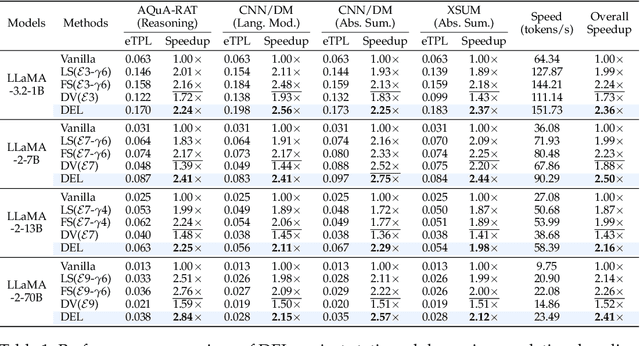


Abstract:Speculative Decoding (SD) is a widely used approach to accelerate the inference of large language models (LLMs) without reducing generation quality. It operates by first using a compact model to draft multiple tokens efficiently, followed by parallel verification using the target LLM. This approach leads to faster inference compared to auto-regressive decoding. While there are multiple approaches to create a draft model, one promising approach is to use early-exit methods. These methods draft candidate tokens by using a subset of layers of the primary model and applying the remaining layers for verification, allowing a single model to handle both drafting and verification. While this technique reduces memory usage and computational cost, its performance relies on the choice of the exit layer for drafting and the number of tokens drafted (speculation length) in each SD round. Prior works use hyperparameter exploration to statically select these values. However, our evaluations show that these hyperparameter values are task-specific, and even within a task they are dependent on the current sequence context. We introduce DEL, a plug-and-play method that adaptively selects the exit layer and speculation length during inference. DEL dynamically tracks the token acceptance rate if the tokens are drafted at each layer of an LLM and uses that knowledge to heuristically select the optimal exit layer and speculation length. Our experiments across a broad range of models and downstream tasks show that DEL achieves overall speedups of $2.16\times$$\sim$$2.50\times$ over vanilla auto-regressive decoding and improves upon the state-of-the-art SD methods by up to $0.27\times$.
Efficient LLM Inference with I/O-Aware Partial KV Cache Recomputation
Nov 26, 2024Abstract:Inference for Large Language Models (LLMs) is computationally demanding. To reduce the cost of auto-regressive decoding, Key-Value (KV) caching is used to store intermediate activations, enabling GPUs to perform only the incremental computation required for each new token. This approach significantly lowers the computational overhead for token generation. However, the memory required for KV caching grows rapidly, often exceeding the capacity of GPU memory. A cost-effective alternative is to offload KV cache to CPU memory, which alleviates GPU memory pressure but shifts the bottleneck to the limited bandwidth of the PCIe connection between the CPU and GPU. Existing methods attempt to address these issues by overlapping GPU computation with I/O or employing CPU-GPU heterogeneous execution, but they are hindered by excessive data movement and dependence on CPU capabilities. In this paper, we introduce an efficient CPU-GPU I/O-aware LLM inference method that avoids transferring the entire KV cache from CPU to GPU by recomputing partial KV cache from activations while concurrently transferring the remaining KV cache via PCIe bus. This approach overlaps GPU recomputation with data transfer to minimize idle GPU time and maximize inference performance. Our method is fully automated by integrating a profiler module that utilizes input characteristics and system hardware information, a scheduler module to optimize the distribution of computation and communication workloads, and a runtime module to efficiently execute the derived execution plan. Experimental results show that our method achieves up to 35.8% lower latency and 46.2% higher throughput during decoding compared to state-of-the-art approaches.
Dynamic Multi-Objective Lion Swarm Optimization with Multi-strategy Fusion: An application in 6R robot trajectory
May 31, 2024Abstract:The advancement of industrialization has fostered innovative swarm intelligence algorithms, with Lion Swarm Optimization (LSO) being notable for its robustness and efficiency. However, multi-objective variants of LSO struggle with poor initialization, local optima entrapment, and slow adaptation to dynamic environments. This study proposes a Dynamic Multi-Objective Lion Swarm Optimization with Multi-strategy Fusion (MF-DMOLSO) to overcome these challenges. MF-DMOLSO includes an initialization unit using chaotic mapping, a position update unit enhancing behavior patterns based on non-domination and diversity, and an external archive update unit. Evaluations on benchmark functions showed MF-DMOLSO outperformed existing algorithms achieving an accuracy that exceeds the comparison algorithm by 90%. Applied to 6R robot trajectory planning, MF-DMOLSO optimized running time and maximum acceleration to 8.3s and 0.3pi rad/s^2, respectively, achieving a set coverage rate of 70.97% compared to 2% by multi-objective particle swarm optimization, thus improving efficiency and reducing mechanical dither.
Ethos: Rectifying Language Models in Orthogonal Parameter Space
Apr 01, 2024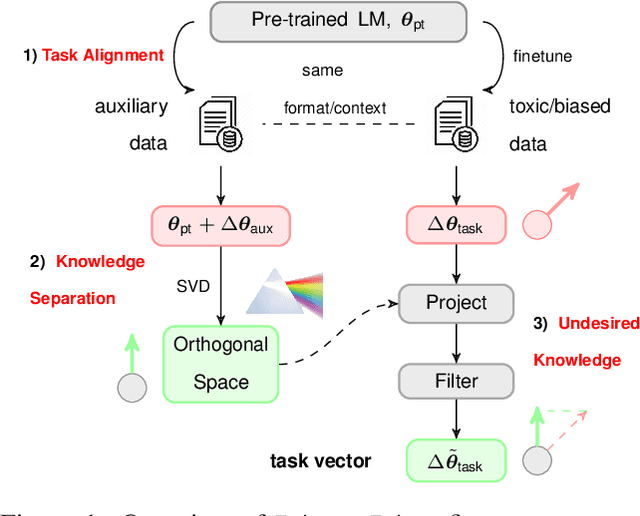

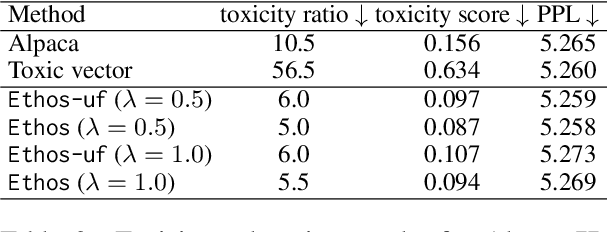
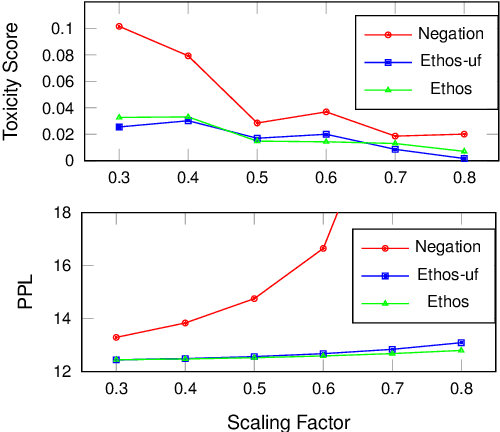
Abstract:Language models (LMs) have greatly propelled the research on natural language processing. However, LMs also raise concerns regarding the generation of biased or toxic content and the potential disclosure of private information from the training dataset. In this work, we present a new efficient approach, Ethos, that rectifies LMs to mitigate toxicity and bias in outputs and avoid privacy leakage. Ethos is built on task arithmetic. However, unlike current task arithmetic algorithms, Ethos distinguishes general beneficial and undesired knowledge when reconstructing task vectors. Specifically, Ethos first obtains a set of principal components from the pre-trained models using singular value decomposition. Then, by projecting the task vector onto principal components, Ethos identifies the principal components that encode general or undesired knowledge. Ethos performs negating using the task vector with undesired knowledge only, thereby minimizing collateral damage on general model utility. We demonstrate the efficacy of our approach on three different tasks: debiasing, detoxification, and memorization unlearning. Evaluations show Ethos is more effective in removing undesired knowledge and maintaining the overall model performance compared to current task arithmetic methods.
Interpretability of Machine Learning: Recent Advances and Future Prospects
Apr 30, 2023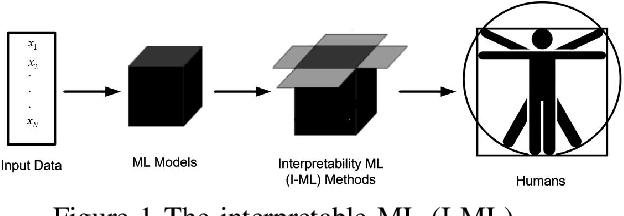
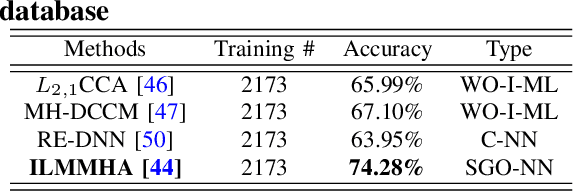
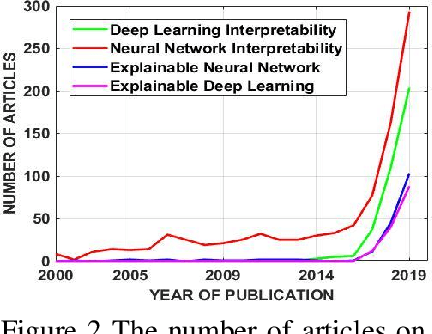
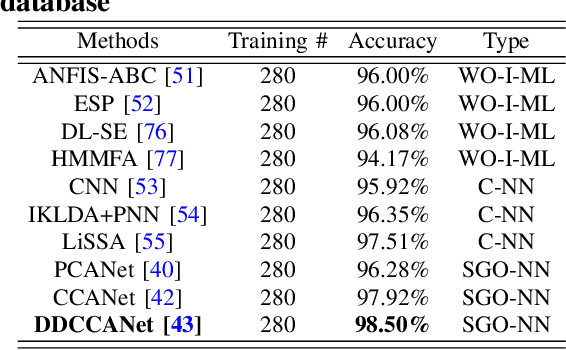
Abstract:The proliferation of machine learning (ML) has drawn unprecedented interest in the study of various multimedia contents such as text, image, audio and video, among others. Consequently, understanding and learning ML-based representations have taken center stage in knowledge discovery in intelligent multimedia research and applications. Nevertheless, the black-box nature of contemporary ML, especially in deep neural networks (DNNs), has posed a primary challenge for ML-based representation learning. To address this black-box problem, the studies on interpretability of ML have attracted tremendous interests in recent years. This paper presents a survey on recent advances and future prospects on interpretability of ML, with several application examples pertinent to multimedia computing, including text-image cross-modal representation learning, face recognition, and the recognition of objects. It is evidently shown that the study of interpretability of ML promises an important research direction, one which is worth further investment in.
TimelyFL: Heterogeneity-aware Asynchronous Federated Learning with Adaptive Partial Training
Apr 14, 2023

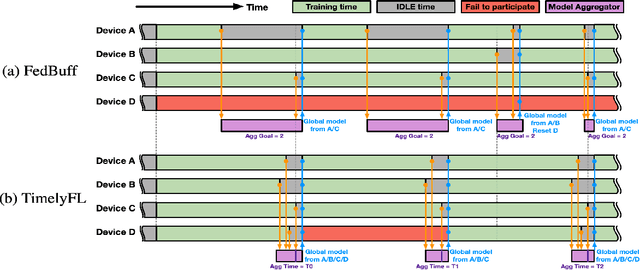

Abstract:In cross-device Federated Learning (FL) environments, scaling synchronous FL methods is challenging as stragglers hinder the training process. Moreover, the availability of each client to join the training is highly variable over time due to system heterogeneities and intermittent connectivity. Recent asynchronous FL methods (e.g., FedBuff) have been proposed to overcome these issues by allowing slower users to continue their work on local training based on stale models and to contribute to aggregation when ready. However, we show empirically that this method can lead to a substantial drop in training accuracy as well as a slower convergence rate. The primary reason is that fast-speed devices contribute to many more rounds of aggregation while others join more intermittently or not at all, and with stale model updates. To overcome this barrier, we propose TimelyFL, a heterogeneity-aware asynchronous FL framework with adaptive partial training. During the training, TimelyFL adjusts the local training workload based on the real-time resource capabilities of each client, aiming to allow more available clients to join in the global update without staleness. We demonstrate the performance benefits of TimelyFL by conducting extensive experiments on various datasets (e.g., CIFAR-10, Google Speech, and Reddit) and models (e.g., ResNet20, VGG11, and ALBERT). In comparison with the state-of-the-art (i.e., FedBuff), our evaluations reveal that TimelyFL improves participation rate by 21.13%, harvests 1.28x - 2.89x more efficiency on convergence rate, and provides a 6.25% increment on test accuracy.
Classification of Lung Pathologies in Neonates using Dual Tree Complex Wavelet Transform
Feb 17, 2023Abstract:Annually 8500 neonatal deaths are reported in the US due to respiratory failure. Recently, Lung Ultrasound (LUS), due to its radiation free nature, portability, and being cheaper is gaining wide acceptability as a diagnostic tool for lung conditions. However, lack of highly trained medical professionals has limited its use especially in remote areas. To address this, an automated screening system that captures characteristics of the LUS patterns can be of significant assistance to clinicians who are not experts in lung ultrasound (LUS) images. In this paper, we propose a feature extraction method designed to quantify the spatially-localized line patterns and texture patterns found in LUS images. Using the dual-tree complex wavelet transform (DTCWT) and four types of common image features we propose a method to classify the LUS images into 6 common neonatal lung conditions. These conditions are normal lung, pneumothorax (PTX), transient tachypnea of the newborn (TTN), respiratory distress syndrome (RDS), chronic lung disease (CLD) and consolidation (CON) that could be pneumonia or atelectasis. The proposed method using DTCWT decomposition extracted global statistical, grey-level co-occurrence matrix (GLCM), grey-level run length matrix (GLRLM) and linear binary pattern (LBP) features to be fed to a linear discriminative analysis (LDA) based classifier. Using 15 best DTCWT features along with 3 clinical features the proposed approach achieved a per-image classification accuracy of 92.78% with a balanced dataset containing 720 images from 24 patients and 74.39% with the larger unbalanced dataset containing 1550 images from 42 patients. Likewise, the proposed method achieved a maximum per-subject classification accuracy of 81.53% with 43 DTCWT features and 3 clinical features using the balanced dataset and 64.97% with 13 DTCWT features and 3 clinical features using the unbalanced dataset.
 Add to Chrome
Add to Chrome Add to Firefox
Add to Firefox Add to Edge
Add to Edge